Chapter-wise NCERT Solutions for Class 8 Science Chapter 12 How Nature Works in Harmony Class 8 Questions and Answers are useful for focused study.
Class 8 Science Chapter 12 How Nature Works in Harmony Question Answer
Science Class 8 Chapter 12 Question Answer How Nature Works in Harmony
How Nature Works in Harmony Class 8 Question Answer (InText)
NCERT Probe and Ponder Questions (Page 190)
Question 1.
How might the loss of forest cover and changes in rainfall patterns lead elephants to enter human farms and villages? (Page 190)
Answer:
Loss of forest cover reduces vegetation and habitat space, while changes in rainfall patterns can dry up waterholes, making food and water scarce in elephants’ natural habitats. As a result, elephants wander into nearby farms and villages in search of crops like bananas and sugarcane, leading to crop damage and potential harm to humans and animals.
Question 2.
Imagine you are a tree in a dense forest. What kind of relationships would you have with water, sunlight, other animals, and other components of the forest? (Page 190)
Answer:
As a tree, I would:
- Water: Absorb water from the soil for photosynthesis and growth.
- Sunlight: Use sunlight to produce food via photosynthesis.
- Other Animals: Provide shelter, food (fruits, leaves), and oxygen for animals; animals like birds and insects aid in pollination and seed dispersal.
- Other Components: Interact with soil for nutrients and stability, contribute to air quality by releasing oxygen, and help retain soil moisture to prevent erosion.
![]()
Question 3.
Do you think the Earth can thrive without humans? Can humans survive without the Earth? (Page 190)
Answer:
- Earth without humans: Yes, Earth can thrive without humans. Ecosystems, such as forests and aquatic systems, function through natural interactions (e.g., food chains, nutrient cycling) without human intervention. Protected areas like national parks show ecosystems can self-sustain.
- Humans without Earth: No, humans cannot survive without Earth, as they depend on ecosystems for air, water, food, and resources essential for survival.
Question 4.
If two kinds of birds compete for the same fruit, how might their way of living change over time? (Page 190)
Answer:
Competition may lead to niche differentiation, where one bird species adapts to feed at different times or on different parts of the fruit tree to reduce competition. Over time, they may evolve distinct beak shapes or feeding behaviours, or one species may dominate, forcing the other to find alternative food sources or habitats.
Question 5.
Can human actions cause natural disasters? (Page 190)
Answer:
Human actions can exacerbate or trigger events that resemble natural disasters. For example, deforestation and pollution can worsen floods or storms by destabilising soil and altering weather patterns. Overuse of pesticides can disrupt ecosystems, indirectly contributing to environmental imbalances.
NCERT Class 8 Science Chapter 12 Question Answer How Nature Works in Harmony (Exercise)
Keep the Curiosity Alive (Pages 207-208)
Question 1.
Refer to the given diagram (Fig.) and select the wrong statement.
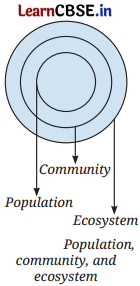
(i) A community is larger than a population.
(ii) A community is smaller than an ecosystem.
(iii) An ecosystem is part of a community.
Answer:
(iii) An ecosystem is part of a community.
Question 2.
A population is part of a community. If all decomposers suddenly disappeared from a forest ecosystem, what changes do you think would occur? Explain why decomposers are essential.
Answer:
Changes: Dead plants and animals would accumulate, nutrients would not return to the soil, and plant growth would decline. This could lead to a reduction in herbivore and carnivore populations due to food scarcity.
Why Essential: Decomposers (e.g., fungi, bacteria) break down dead matter into simpler substances, recycling nutrients like nitrogen and carbon back into the soil for plants. Without them, the nutrient cycle would stop, disrupting the food web.
Question 3.
Selvam from Cuddalore district, Tamil Nadu, shared that his milage was less affected by the 2004 Tsunami compared to nearby milages due to the presence of mangrove forests. This surprised Sarita, Shabnam, and Shijo. They wondered if mangroves were protecting the village. Can you help them understand this?
Answer:
Yes, mangroves protected the village. Mangrove forests act as natural barriers, slowing down strong winds and waves during storms and tsunamis. Their roots stabilize soil, reducing erosion, and they absorb water impact, protecting coastal areas. The Sundarbans’ mangroves, a World Heritage Site, demonstrate this protective role.
![]()
Question 4.
Look at this food chain:
Grass → Grasshopper → Frog → Snake
If frogs disappear from this ecosystem, what will happen to the population of grasshoppers and snakes? Why?
Answer:
- Grasshoppers: The population would likely increase because frogs, their main predators, are gone, reducing predation pressure.
- Snakes: The population would decrease because frogs are their primary food source, leading to food scarcity.
- Why: In a food chain, the removal of a middle trophic level (frogs) disrupts the balance. Fewer predators allow prey (grasshoppers) to multiply, while the loss of prey affects higher predators (snakes).
Question 5.
In a school garden, students noticed fewer butterflies the previous season. What could be the possible reasons? What steps can students take to have more butterflies on campus?
Answer:
- Possible reasons: Possible causes include pesticide use killing larvae, loss of nectar plants, or increased predators (e.g., birds). Monoculture or pollution might also reduce habitat quality.
- The steps we can take: Plant diverse nectar-rich flowers (e.g., marigolds), avoid pesticides, create sheltered areas, and install butterfly feeders or water sources to attract and support butterflies.
Question 6.
Why is it not possible to have an ecosystem with only producers and no consumers or decomposers?
Answer:
An ecosystem needs consumers to regulate producer populations (e.g., herbivores eat plants) and decomposers to recycle dead matter into nutrients for producers. Without consumers, producers would overgrow and die from competition; without decomposers, nutrients would not cycle, collapsing the system.
Question 7.
Observe two different places near your home or school (e.g., a park and a roadside). List the living and non¬living components you see. How are the two ecosystems different?
Answer:
We can see some common things near our home and school, such as
- Park: Living (trees, birds, squirrels, grass); Non-living (soil, water, benches, sunlight).
- Roadside: Living (weeds, insects); Non-living (asphalt, dust, car exhaust).
Differences: The park is a designed ecosystem with diverse plants and animals, supported by soil and water, while the roadside is a disturbed, human-altered area with fewer species and more pollution.
Question 8.
‘Human-made ecosystems like agricultural fields are necessary, but they must be made sustainable.’ Comment on the statement.
Answer:
Agree. Agricultural fields provide food but often use unsustainable practices (e.g., synthetic fertilisers, monoculture) that degrade soil and harm biodiversity. Sustainable methods (e.g., organic farming, crop rotation) ensure long-term productivity and environmental health.
![]()
Question 9.
If the Indian hare population (Fig.) drops because of a disease, how would it affect the number of other organisms?
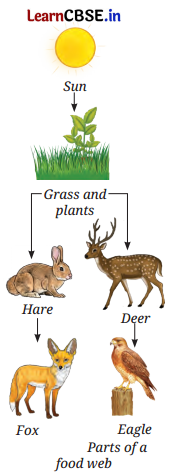
Answer:
- Predators: The numbers of foxes and eagles would decrease due to reduced prey (hares), leading to food scarcity.
- Plants: Grass and plant populations might increase initially without hare grazing, but overgrowth could alter the habitat.
- Deer: Since deer aren’t preyed on by foxes or eagles, their role in this particular chain isn’t disturbed directly.
- Why: A decline in a key herbivore like the hare disrupts the food web, affecting both higher (predators) and lower (plants) trophic levels.
Class 8 How Nature Works in Harmony Question Answer (Activities)
Activity 12.1: Let us Explore (Page 191)
Caution: Explore the habitat in groups with your teacher.
Identify two habitats in your surroundings.
These could be any two of the following: a pond, a forest, an agricultural farm, or even a large tree like a banyan, mango, or pilkhan (white fig) tree.
List the living beings and non-living things that you observe in these habitats.
Record your observations in the Table.
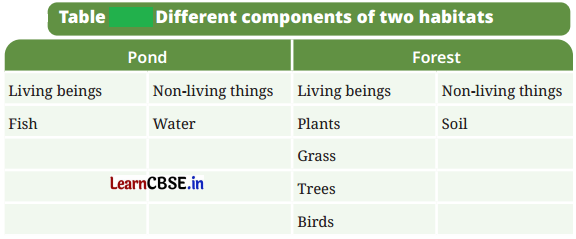
Answer:
Pond: Noticed fish swimming and water as the main components.
Forest: Observed plants (grass, trees), birds, and soil as key elements.
Recorded Observations in a Table.
Different components of two habitats
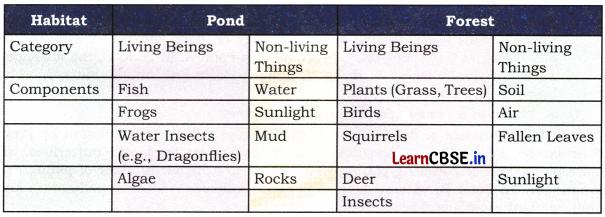
Activity 12.2: Let us Record (Page 193)
We can understand the population of a particular type of plant by counting them at a given place and time.
Divide students into four to five groups.
Each group may identify any two organisms, plant(s) or animal(s).
Mark an area of 1 m × 1 m in your school garden.
Identify four organisms in this area, and count their numbers.
Record the number of organisms in the Table.
Compile the data from all groups.
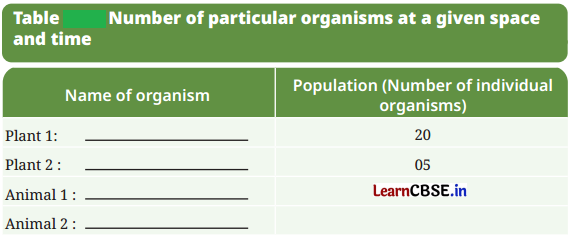
Answer:
Number of particular organisms at a given space and time
| Name of Organism | Population (Number of individual organisms) |
| Plant 1: (e.g., Grass) | 20 |
| Plant 2: (e.g., Marigold) | 5 |
| Animal 1: (e.g., Ants) | 10 |
| Animal 2: (e.g., Ladybug) | 3 |
Activity 12.3: Let us Read (Page 194)
Researchers conducted a study to see how fish in ponds affect seed production in the plants nearby. They observed two ponds with fish and a large number of flowering plants around them; B without fish and fewer flowering plants around it (Fig.). Think of a reason for these observations.

Question 1.
Compare the number of dragonflies, bees, and butterflies in both ponds.
Answer:
Pond A (with fish): Fewer dragonflies, more bees and butterflies.
Pond B (without fish): More dragonflies, fewer bees and butterflies.
Reason: Fish eat dragonfly larvae, reducing the adult dragonfly population in Pond A. With fewer dragonflies (which prey on bees and butterflies), the number of pollinators (bees, butterflies) increases in Pond A. In Pond B, the absence of fish allows dragonfly larvae to thrive, leading to more dragonflies that reduce bee and butterfly populations.
Question 2.
Think of a reason for these observations.
Answer:
The presence of fish in Pond A controls the dragonfly population by preying on their larvae. Fewer dragonflies mean less predation on bees and butterflies, allowing more pollination of flowering plants, which leads to a higher number of plants and seed production. In Pond B, without fish, dragonflies increase, reducing pollinators and thus limiting plant growth and seed production.
![]()
Question 3.
What does this study show? How does the population of fish in a pond affect seed production in nearby plants?
Answer:
What it shows: The study demonstrates an indirect effect where fish influence plant seed production through the food web. Fish reduce dragonfly larvae, leading to fewer dragonflies, which allows more bees and butterflies to pollinate plants, increasing seed production.
Effect of fish population: A higher fish population in a pond decreases dragonfly numbers, indirectly boosting pollinator populations (bees, butterflies), which enhances pollination and seed production in nearby plants. Conversely, no fish (as in Pond B) leads to more dragonflies, fewer pollinators, and lower seed production.
Activity 12.5: Let us Classify (Pages 197-198)
Observe Fig. (b), which illustrates a forest ecosystem.
Study the picture carefully and spot the organisms listed in the Table.
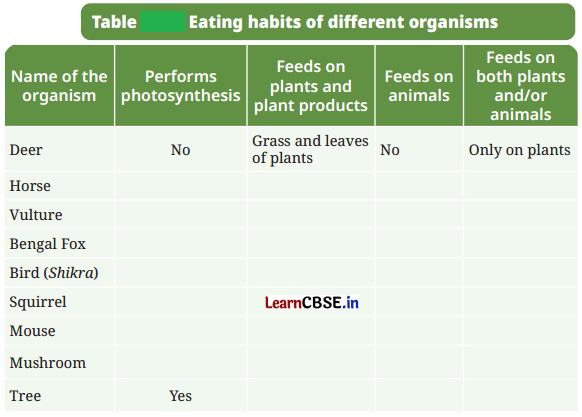
Using the internet or your school library, find out what these organisms eat.
Record your observations in the Table by identifying whether each organism feeds only on plants and plant products, only on animals, or on both.
Answer:
Deer: Eats grass and leaves (herbivore).
Horse: Eats grass and hay (herbivore).
Vulture: Eats dead animals (carnivore).
Bengal Fox: Eats both plants (fruits) and animals (small mammals) (omnivore).
Bird (Shikra): Eats other birds and small animals (carnivore).
Squirrel: Eats nuts and seeds (herbivore, though some species may eat insects occasionally).
Mouse: Eats seeds and insects (omnivore).
Mushroom: Decomposes dead organic matter (not a producer, but a decomposer/saprotroph).
Tree: Performs photosynthesis to make its own food (producer).
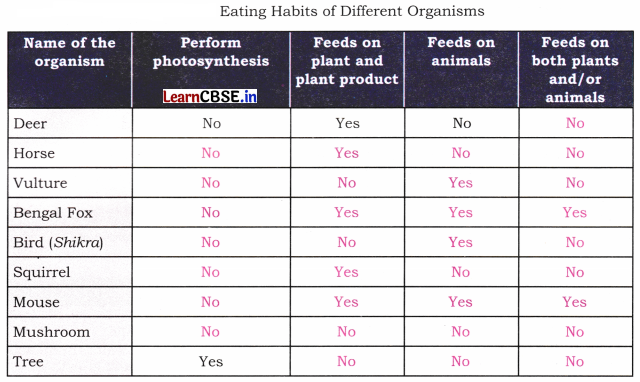
Activity 12.7: Let us Draw (Pages 199-200)
Figure (a) represents a crop field with millets, mice, and an eagle.
Count the number of each type of organism in Fig. (a).
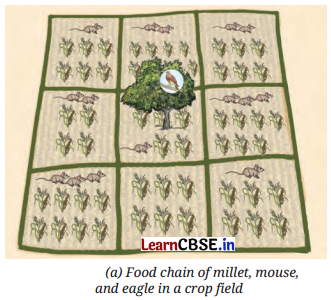
Make a table and set a number in the table against each of the organisms.
Arrange the numbers in ascending order, consider the highest number at the base, and the lowest at the top.
Place the mouse, millet, and eagle appropriately in Fig. (b).
What figure do you get? It looks like a pyramid. Complete the pyramid in Fig. (b).
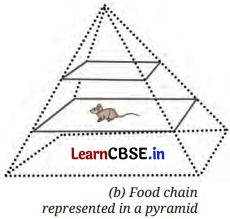
Each organism in a food chain has a specific position, called a trophic level (troph=food):
Producers (like green plants) are at the first trophic level.
Herbivores (like hares and deer) are at the second level.
Small carnivores (like frogs) are at the third level.
Large carnivores (like tigers or vultures) occupy the next level.
Answer:
Sample Observations (assumed counts based on ecological pyramid trends):
Millets: 100 individuals (producers are typically most abundant).
Mouse: 20 individuals (herbivores are fewer than producers).
Eagle: 2 individuals (top carnivores are least abundant).

Recorded Data in Table
| Organism | Number of Individuals |
| Millet | 100 |
| Mouse | 20 |
| Eagle | 2 |
The post How Nature Works in Harmony Class 8 Questions and Answers Science Chapter 12 appeared first on Learn CBSE.
📚 NCsolve - Your Global Education Partner 🌍
Empowering Students with AI-Driven Learning Solutions
Welcome to NCsolve — your trusted educational platform designed to support students worldwide. Whether you're preparing for Class 10, Class 11, or Class 12, NCsolve offers a wide range of learning resources powered by AI Education.
Our platform is committed to providing detailed solutions, effective study techniques, and reliable content to help you achieve academic success. With our AI-driven tools, you can now access personalized study guides, practice tests, and interactive learning experiences from anywhere in the world.
🔎 Why Choose NCsolve?
At NCsolve, we believe in smart learning. Our platform offers:
- ✅ AI-powered solutions for faster and accurate learning.
- ✅ Step-by-step NCERT Solutions for all subjects.
- ✅ Access to Sample Papers and Previous Year Questions.
- ✅ Detailed explanations to strengthen your concepts.
- ✅ Regular updates on exams, syllabus changes, and study tips.
- ✅ Support for students worldwide with multi-language content.
🌐 Explore Our Websites:
🔹 ncsolve.blogspot.com
🔹 ncsolve-global.blogspot.com
🔹 edu-ai.blogspot.com
📲 Connect With Us:
👍 Facebook: NCsolve
📧 Email: ncsolve@yopmail.com

😇 WHAT'S YOUR DOUBT DEAR ☕️
🌎 YOU'RE BEST 🏆